Abstract
The paper deals with an optimization problem in an electricity distribution network with different types of distributed generation and a battery storage system in terms of a smart grid concept. The optimization problem considers two objectives, namely, the annual energy losses and the exchange of energy with the higher-level power grid. The decision variables of the problem are the allocation of the different distributed generation units and the battery storage system, the annual power profiles of the controllable distributed generation and the battery storage system, and the power factor profiles of the controllable and noncontrollable distributed generation. All decision variables are solved simultaneously in a single optimization problem. The variable load shapes of the grid consumers and the profiles of the photovoltaic and wind power systems are considered in the study. All data are observed at the annual level with hourly resolution. The problem solving method uses computational intelligence techniques, namely, metaheuristic optimization methods and artificial neural networks. The study proposes a framework for optimizing the decision variables in the planning phase of distributed generation and battery storage, and for controlling the variable power and power factor profiles based on an artificial neural network in the implementation phase. The optimization problem is solved with a power system simulation program and a metaheuristic optimizer in cosimulation synergy. The three cases of distributed generation and battery storage are considered simultaneously. The proposed method is applied to the test grid operator IEEE with 37 buses, and reductions in annual energy losses and energy exchange are obtained in the ranges 34–86% and 41–99%, respectively.
1. Introduction
Due to their environmental characteristics, renewable energy sources are increasingly used in power grids. Renewable energy sources utilize primary energy sources in the form of solar energy, wind, and water flow. In addition to these primary energy sources, renewable energy sources also include biogas-powered sources. Since renewable energy sources are very attractive from an environmental point of view, their use in the power system presents a technical challenge. The intensity of primary energy varies and is naturally determined by meteorological conditions. Depending on the primary energy content (per unit area or volume), the technical realization of renewable sources is associated with production units of lower power. Therefore, renewable energy sources are classified as distributed sources, usually referred to as distributed generation (DG). Due to these technical characteristics of renewable energy sources, intensive scientific and research efforts are currently required to propose solutions for the high-quality implementation of decentralized energy production in current and future practice. Due to the different intensity of the primary energy source, the use of a battery energy storage system (BESS) is also promoted to increase the utilization of the primary energy source. The studies in this area are related to the planning of the optimal allocation of the distributed sources in the planning phase and the optimization of the management of the duty cycle of the battery units and the management of the distributed generation. The need to develop the modeling and management of battery storage and renewable energy sources must be seen in the context of the introduction and implementation of the advanced grid concept.
In [1], an overview of the current deployment of batteries in the distribution grid for different battery technologies is provided. It also highlights the purpose of using battery energy in modern advanced grids, which is to improve power quality, control voltage and frequency in the grid, reduce peak demand, control consumption, and trade electricity. Depending on the purpose of the storage capacity of batteries in the power grid, different algorithms and methods are used to manage the battery power in its cycle. In addition to researching the impact of battery storage in power grids, there is a need to develop and propose procedures and methods for battery allocation and battery power/energy management.
The authors in [2] present the optimization of prosumers’ energy storage profile with the aim of determining prosumers’ trading strategy considering renewable energy uncertainty. The locations of renewable energy sources and energy storage are given and are not considered in the problem. It is also investigated how the use of energy storage at the prosumer’s location affects the size of the photovoltaic system. In [3], an optimal dispatch strategy for given DG and BESS sites in a power system is presented. The study optimizes the dispatch strategy considering the variability of generation sources and loads and focuses on the system economics based on increased forecast accuracy at the daily level. In [4], an optimization of peer-to-peer energy trading is proposed that takes into account renewable energy uncertainties and individual preferences of prosumers. Again, the locations of DGs are not part of the optimization and are taken as given. Optimization of peer-to-peer power distribution between smart public buildings and the main power grid using a typical daily yield scenario for wind and light without optimizing DG locations in the system is described in [5]. In [6], the configuration and profiles of a cloud energy storage system are presented. The study considers load variations during the day without considering the location of the cloud energy storage system in the power grid. For an overview of smart energy system optimization research considering the economics of integrating and controlling DGs and BESS, one can see [7]. As can be seen in [7] and in the literature review in this paragraph, optimization considering energy price is not about optimizing the size and locations of DGs and BESS in the system.
In [8], the authors solve the optimization problem of optimal allocation of distributed generation using the DG cost objective, network cost, and environmental improvement index functions. The problem is solved by applying a gradient method that does not rely on a simple solution. The investment costs of distributed generation, batteries, and capacitor banks and the voltage stability index are calculated as functions of the objective in solving the problem of optimal allocation of distributed generation, batteries, and capacitor banks in [9]. The model assumes constant DG production and loads. The authors used the multiobjective ant lion optimizer as a metaheuristic optimization method.
In [10], the authors presented battery storage performance optimization for a multiobjective problem with two objective functions, daily losses and battery consumption size. The population-based optimization technique, particle swarm optimization (PSO), is a tool for optimization. In this study, the variable loads are considered over an annual period with hourly resolution. The authors in [11] formulated the multiobjective problem of optimal allocation of DG and BESS considering DG and BESS acquisition costs and pollutant emissions as two objectives. The metaheuristic multiobjective ant lion optimizer (MOALO) is used to solve the problem considering daily changes (with hourly resolution) in loads and DG productions. The total production cost and pollutant impact are used as objectives in the optimal DG allocation problem presented in [12]. The two metaheuristic methods, the bacterial foraging optimization (BFO) algorithm and the firefly optimization algorithm (FA), are used to solve the problem. The time horizon considered in the optimization was 1 day with hourly input data.
The authors in [13] studied the problem of optimal DG allocation considering variable load and DG production. For the simulations, 12 typical days with minute-level input data were used. Minimization of DG capacity and power losses are considered as objectives in two separate studies. In [14], evolutionary algorithms are used to find an optimal allocation of DG, considering maximizing the penetration of DG in the power grid. The value of the objective function is calculated by implementing power flow equations in the presented method. Constant load values and production of DG are implemented in the optimization model. In [15], the optimal DG allocation is solved by metaheuristic algorithms that consider the minimization of power losses in the power system. Constant DG production and load values are assumed, and the power flow calculation is coded together with the optimization algorithm in the programming environment. The authors in [16] used a metaheuristic optimization based on PSO for the optimal allocation of DG, considering the minimization of power losses as the objective function of the problem. The constant DG power and load are considered, and the power flow calculation is coded along with the optimization algorithm.
The method of automatic generation for DG power control is presented in [17]. The metaheuristic firefly algorithm (FA) is used to solve the optimization problem of optimal DG power allocation among different DGs in the case of variable load. In the paper [18], the authors optimized the power supply in a microgrid consisting of electric vehicles (EV) as sources. The objective function of the optimization problem is composed of two objectives, the operating cost and the environmental cost of the microgrid. The problem is solved using two metaheuristic optimization algorithms that take into account both the variable production of the wind turbines and the energy price and charging power of the EVs. In [19], a PSO-based metaheuristic optimization method is applied to solve the economic dispatch problem in a power system with thermal and wind power plant DG. Variable load and DG production are considered in the study.
Constant DG production and network loads are considered in [20] to solve an optimal DG allocation problem with the objective of improving the voltage profile of the distribution network and minimizing the DG purchase cost. The genetic algorithm (GA) is used as an optimization method. The power system is simulated using the OpenDSS software, and the optimization algorithm is implemented in a MATLAB programming environment. In [21], the optimal allocation of DG production units is performed considering the minimization of power losses and the improvement of the voltage profile of the grid. Metaheuristic methods are used to solve the problem with constant network loads and DG production. In [22], the researchers applied the grasshopper optimization algorithm (GOA) to find an optimal allocation of DG, shunt capacitors, and EV charging stations in the power distribution network. The optimization problem is solved for peak load and variable grid load, and DG impact on grid operation is studied for peak-load-obtained optimal allocations. The optimal DG allocation problem solved by a metaheuristic algorithm that considers minimization of power losses as an objective function is presented in [23].
The cosimulation approach, which uses MATLAB for the coding optimization method and OpenDSS for the power system simulation, is used in research. The DG production and the grid load are modeled with constant values. Minimizing the network losses and voltage deviation and maximizing the network stability index are the objectives of the research presented in [24], and metaheuristic optimization is applied to solve the optimal DG allocation problem. In the paper, constant network load and DG production are studied. In [25], the PSO algorithm is used to solve the optimal DG allocation problem with the objectives of minimizing power losses and voltage deviations. In the tested power system, constant load and DG production are assumed in this study. Minimizing power losses and voltage deviations are also objectives of the DG allocation optimization problem in [26]. Metaheuristic optimization methods are used, and three load levels are considered in the simulations. Variable load and DG production are considered in the optimal DG allocation problem in [27]. Differential evolution (DE) is used as an optimization algorithm to solve the problem. Optimal control of DG power factors based on measured DG and substation power inputs is also determined for previously specified DG locations and sizes.
In [28], the authors applied a metaheuristic optimization method, namely, the African buffalo optimization algorithm, to simultaneously solve for the optimal allocation of wind power (WP) and battery storage systems (BEES) and the optimal charge/discharge profile of BEES. The authors used a two-stage optimization called outer layer and inner layer optimization to solve the problem. This approach was the motivation and inspiration for our research presented here.
Based on the above review of the current literature on optimal DG and BESS allocation and control, the following conclusions can be drawn:
- Most research uses metaheuristic optimization techniques due to the complexity of the problem.
- The optimization method and the computation of the objectives and constraints (based on the power flow computation) of the optimization problem are coded in parallel in a programming environment.
- The load values and the output power DG are considered constant or the typical profile with a lower number of input data in a series of studies.
Our study focuses on the issue of optimal allocation and management of distributed generation and battery storage, with a number of key aspects contributing to the topic:
- Simultaneously optimizing DG and BESS allocation and control of unit outputs using a cosimulation approach;
- Performing optimization processes considering variable input data at the annual level;
- Application of a two-stage optimization framework to reduce the dimensionality of the optimization problem;
- Use of ANN to estimate DG and BESS profiles for data different from those used in the optimization procedure.
The proposed optimization framework is the continuation of the authors’ research [29] with the following improvements:
- In [29], the power factors of all DGs (PV, wind, biogas) are considered constant; in this research, the power factors are variable and are controlled by ANN.
- In [29], the installations of BESS in the power grid are not considered.
- In [29], the input data to determine the profile of the biogas plant are the load curves of the consumers; in this research, the input data to determine the power factor profile of all DGs and the power profiles of biogas DG and BESS are measured voltages, SoC of BESS, and the PV and wind generation DG at a given time.
The proposed procedure attempts to contribute to the topic of optimal allocation of DG and BESS and their optimal profiles with respect to the next two topics. A review of the literature on this topic shows that the optimal allocation of DG and BESS takes into account the fixed loads and/or the production of DGs, or counts with variable loads at the daily or weekly level. However, it is questionable whether the optimal allocation and BESS profile determined using the data of a particular day/week are optimal for other days/weeks of a year. Since the profiles of the renewable energy sources PV and wind DG and the load profile have fewer or more annual cycles, it is reasonable to consider the variability of the input data at the annual level when solving the given optimization problem. Another problem related to the optimization problem is the optimal control of the controllable DG power and the BESS operating state at a given time with the aim of reducing the annual energy losses in the grid. Solving these two problems requires a large computational effort due to the large amount of data; e.g., at hourly resolution at the annual level, there are 8760 data for which power flow calculations must be performed for only one of the possible optimal solutions. As the temporal resolution of the input data increases, both the amount of data and the computational cost increase rapidly. The method proposed in this paper solves both problems by
- Simultaneously optimizing the allocation of DG and BESS, the power factor profiles of DG, the generation profile of controllable DG, and the charge/discharge profile of BESS;
- Predicting the optimal power factor of DG, the generation of controllable DG, and the charge/discharge state of BESS at a given time using ANN.
The proposed method assumes a steady state of the distribution network; i.e., it is based on load flow calculations. From the above literature review of research in this area, it appears that such an approach is not used for the observed optimization problem, or is used very rarely.
The remainder of the article is organized as follows: Section 2 presents the formulations of the optimization problem of DG and BESS power scheduling and allocation. Section 3 presents the proposed method and describes the tools used. Section 4 shows the application of the proposed method to solve the optimization problem using a case study for a power distribution network. Section 5 draws the conclusions from the research.
2. Motivation for the Research
Based on the literature review given in the previous section, the modeling of the optimization problem involves several different levels of realistic modeling of system parts as well as the variability of quantities associated with the problem. Table 1 provides an overview of the parts of the system modeled in the literature and the variability of the variables used in the formulation of the optimization problem.

Table 1.
Researched literature overview regarding modeled system elements and variability of the quantities used in the formulation of the optimization problem (✓ —considered in research, ✗ —not considered in research).
The main goal of the research presented here concerns as many elements as possible of the given optimization problem of optimal DG and BESS assignment with the aim of increasing the realism of the model rather than improving a particular optimization technique/algorithm. A procedure/framework is developed for applying different computational tools in a simulation environment (formulated through cosimulation setup) to solve this very complex optimization problem. The main objective of the research is to show how the whole optimization process can be formulated to take into account as much as possible the real situation in terms of changes of variables over time or year, with fewer or more repetitions of the variable quantities over a longer period of time (a decade or some years). This requires the simultaneous processing and consideration of many time-varying variables. Therefore, the paper proposes a framework that includes a more realistic modeling of the problem of optimal allocation of DG and BSEE.
3. Description of the Optimization Problem
The optimization problem investigated in this study involves the simultaneous search for the optimal allocation of BEES, controllable (biogas plants) and noncontrollable (PV and wind plants) DG sources and controlled power profiles of BESS and controllable DG units. Optimizing the power factor over time of controllable and noncontrollable DG is also part of the optimization problem. The technical objectives are considered in the problem. The main interest in installing DG in the power grid is to reduce the energy losses in the distribution grid, which is used as one of the objectives. In addition, one of the objectives of the smart grid concept is to increase DG production in the distribution network to reduce energy exchange with the higher-level (transmission) network. These two “standard” objectives of implementing DG in the distribution grid are objectives that are considered here as objective functions of the optimization problem. The problem formulation also defines technical constraints that take into account the limits of the node voltages and the transmission capacity of the lines.
3.1. Objective Function 1: Annual Energy Losses
The energy losses in the power distribution system at the annual level are used as the objective function for the optimization problem. This objective function is defined as
where are annual network energy losses, n is the number of periods, and are active power losses for period i and duration of period i.
3.2. Objective Function 2: Exchange of Annual Energy with the Upstream Power System
One of the ideas in implementing DG in the power distribution system is to generate energy locally near the consumers to make the local power distribution system as sustainable as possible. In addition, such an approach reduces losses in the system and the cost of purchasing energy from the higher-level power grid. The total annual amount of energy exchanged with the higher-level grid can be defined as follows:
where is the annual energy (include active and reactive energy) exchange between the distribution and up-level network, and , , and are apparent, active, reactive power exchanged for period i, respectively.
3.3. Multiobjective Approach
Since there are numerical differences between objectives (1) and (2), multiobjective optimization is used to avoid the inclusion of aggregate objective functions with weighting factors:
When applying an aggregation approach to a natural multiobjective problem in order to transform it into a single-objective optimization problem, numerical problems may arise that make it difficult for the optimization algorithm to solve the problem, which in turn may affect the quality of the solution. This numerical problem originates from the fact that the numerical difference between the values of the objective function is of the order of –. This can affect the two possible solutions in the following way. The significant change in one of the objective values may have such an overall effect on the aggregate single-objective function that the change in the other objective value is negligible.
3.4. The Constraints of the Optimization Problem
The constraints of the optimization problem refer to the ranges of the node voltages and the current limits of the power lines. The node voltage, line current, and box (decision variable ranges) constraints are in the form of inequality constraints:
where , , and are minimum, calculated, and maximum nodal voltage, respectively, and and are calculated and maximum (rated) line current, respectively.
4. Proposed Cosimulation for Solving the Optimization Problem
As mentioned above, the optimization problem under study involves the optimal allocation of the units DG and BESS and the controllable variables of DG and BESS. The allocation of the units means finding the optimal locations and nominal capacities (sizes) of the BESS, PV, wind and biogas plants. The controllable variables included in the optimization problem are the power factors of the units of the PV, wind, and biogas plants DG and the power profiles of the biogas plants and BESS units.
4.1. Cosimulation Setup
The cosimulation approach used to solve the problems (3) and (4) uses a software tool specialized in power system modeling and simulation and an optimization tool that implements a metaheuristic optimization method (Figure 1). Such an approach allows for more realistic modeling of the power distribution system by incorporating models for all parts of the modern distribution system. The disadvantage of such an approach is the fact that the objective function and the constraints of the optimization problem are calculated by simulation. This means that the optimization procedure is a kind of “black box” optimization. Since the optimization problem cannot be expressed in an analytical form, a metaheuristic optimization technique must be used in this case. A metaheuristic optimization technique is suitable for finding a near-optimal solution because it requires only numerical values for the objectives and constraints (which is the case when using the simulation tool), without requiring an analytical formulation of the problem. The developed cosimulation setup is shown in Figure 1. The OpenDSS software, version 9.4.0.3, ([30]) is used as a tool for simulating the power distribution system, which performs the calculations to determine the values for the optimization objective and constraints. OpenDSS is intended for the simulation of modern power distribution networks and is very suitable for the implementation of cosimulation, as it provides a number of interfaces to different programming languages, such as MATLAB, Python, C, Java, and Julia. The metaheuristic optimization tool MIDACO (mixed-integer distributed ant colony optimization [31]), version 5.0, is used here to solve the optimization (1). MIDACO as a metaheuristic optimization tool has interfaces for different programming languages (MATLAB, Python, C, Java, Julia, etc.), so it can be easily implemented in a cosimulation. MIDACO is used for an outside optimization loop and for an inside optimization loop; the differential evolution (DE) algorithm [32] from the SciPy ([33]), version 1.9.0, Python, version 3.11.0, package is used.
4.2. Proposed Framework for the Optimization Procedure
As presented in the introduction at the beginning of the article, in most studies, the optimal allocation of DG and BESS is solved for constant loads in the system. In the case of considering variable loads and DG productions, a short time period (e.g., a day with hourly resolution) or a characteristic day, week, or month is usually used. For weekly, monthly, or annual changes, the averaged daily, weekly, or monthly values, respectively, are used. In addition, the allocation problem is solved alone, without considering the simultaneous management of generation output. The main reason for solving the allocation optimization problem and the energy management optimization separately is the huge amount of data that is generated when we try to solve both optimization tasks simultaneously, especially in the case of an annual horizon with hourly (or even 1 or 15 min) data resolution. Such an amount of data requires a very high computational effort to solve the problem. This effort is caused not only by the amount of input data, but also by the number of decision variables. When the allocation of units and power profiles is included in an optimization, the number of decision variables is equal to the number of allocated units times the number of periods (8760 periods per year with hourly data resolution). This leads to tens of thousands of decision variables, which makes solving the optimization problem very difficult. In the study, a two-stage optimization procedure is proposed to overcome the high dimensionality of the optimization problem. Two optimizations are proposed, one of which is within the other. These two optimization procedures (two levels of optimization) are referred to here as the external optimization procedure and the internal optimization procedure. The external procedure controls the optimal allocation of the units DG and BESS. Here, the internal optimization finds the optimal power factor profile of all DG and output power profiles of the controllable units DG and BESS for each time period t over the entire annual horizon. In this way, the optimization of the power factor and power profiles for each time period t is solved by a new optimization. The proposed optimization framework ensures that the optimal DG and BESS allocation is found simulatively along with the optimal power and power factor profiles of the units (DG and BESS). The decision vectors of the optimization problem (3) described above can be written down as follows:
where and are decision variable vectors of outside and inside optimization levels, respectively; , , and are rated apparent powers (sizes) of PV, wind, and biogas plants; and are rated capacity (size) and power of BESS; , , , and are locations of the PV, wind, biogas plants, and BESS, respectively; , , and are phase shifts between voltage and current (defining power factors) of the PV, wind, and biogas plants, respectively; and and are load shape values of the biogas plant and BESS for the period . The optimization procedure is carried out using the input data from PV and wind power plants and the load profiles of the consumers. These load profiles are usually estimated based on historical data using developed estimation and forecasting methods. However, after the installation of DG and BESS in the distribution network, the real data of DG generation and consumer load profiles may differ from those used for optimization in the planning phase of the DG and BESS installation project. This means that the optimal profiles of DG and BESS determined in the planning phase may not be as well matched with the different input data. ANN is used to control the power profiles of the controllable DG and BESS to solve this problem after DG and BESS are installed in the power distribution network. The inputs to ANN are the node voltages of the busses where DG and BESS are installed, and the outputs of ANN are the decision variables of the internal optimization (i.e., the power and power factor profiles of DG and BESS). After training ANN with the data obtained during the optimization procedure, the learned ANN is used to estimate the optimal profiles of DG and BESS in case the data differ from those used in the optimization in the previous step of the procedure. The ANN structure used in this study is shown in Figure 2. The whole developed and proposed framework, based on cosimulation, two-step optimization, and ANN prediction (Figure 3), was implemented in the Python programming environment. A schematic overview of the developed framework is given in Figure 4.
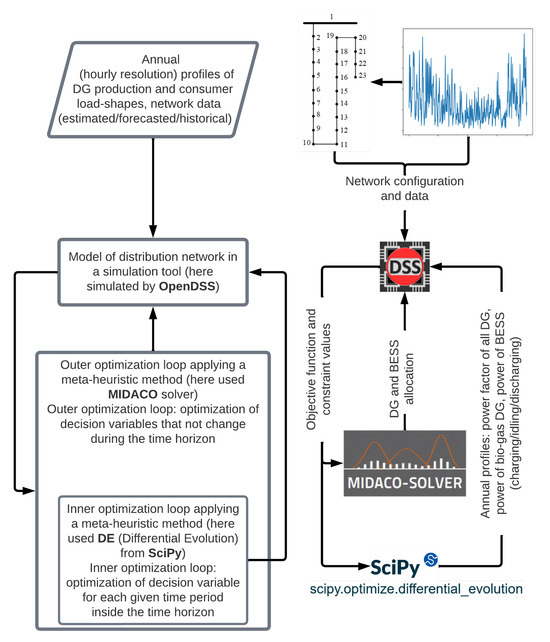
Figure 1.
Overview of the proposed optimization process based on cosimulation setup (Step 1 from the developed framework given on Figure 3).
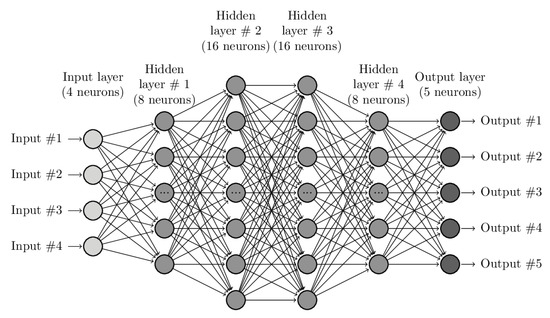
Figure 2.
The structure of ANN used to estimate optimal power factors of DG and power profiles of biogas DG and BESS in the implementation phase (Step 2 from the developed framework given in Figure 3).
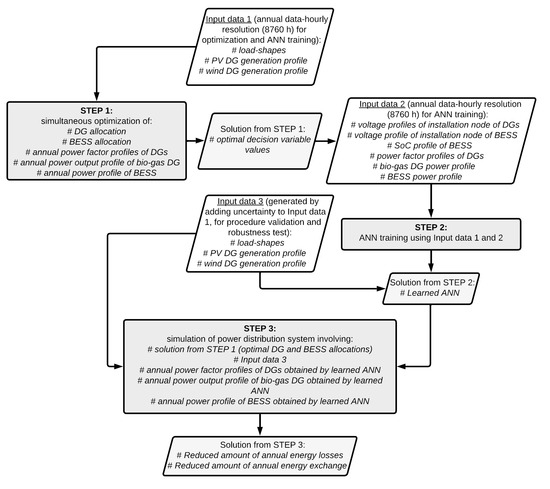
Figure 3.
Workflow of the proposed procedure for the optimization of allocation and output profiles of BESS and DG.
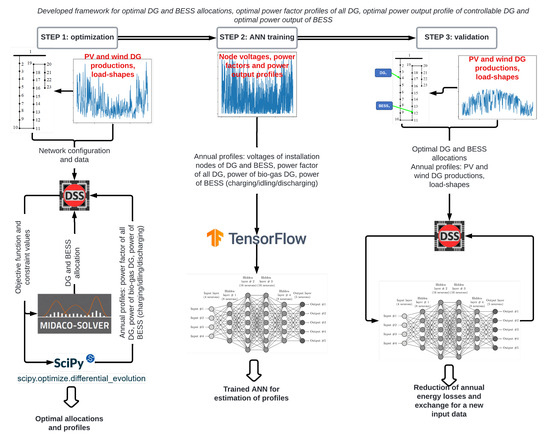
Figure 4.
Schematic overview of developed procedure for optimization of allocation and output profiles of BESS and DG.
During the first test of the optimization process, which includes the simultaneous installation of PV, wind, and biogas plant DG and BESS, the significant influence of the given power profiles of PV and wind DG on the final optimization result was found. For this reason, three different cases are analyzed, including the installation of all types of DG and BESS (Case 1), the installation of all types of DG without BESS (Case 2), and the installation of PV and wind DG and BESS without the installation of biogas DG. A brief overview of the cases studied can be found in Table 2.

Table 2.
Different combinations of DG and BESS unit installations investigated in the study (✓ —DG/BESS used in case, ✗ —DG/BESS not used in case).
4.3. Details of the Step-by-Step
Procedure and Tools Used
In the main steps of the proposed procedure described above (Figure 4), the different computational tools are used. In this section, some details about each step and the tools used in the process are presented.
Step 1
In this step, optimization of DG allocations and power profiles of controllable DGs (biogas plants) is performed. OpenDSS, DE, and MIDACO software are used together to calculate the values of the objective functions and find the optimal allocation and DG profile. Two simultaneous optimization phases are performed, namely, the inner and outer optimizations (Figure 1). In the outer optimization loop, the MIDACO solver is used to find the optimal allocation of DG, considering the simultaneous annual profiles of loads, PV and wind energy sources, and the profiles controlled by DE, namely, the biogas power generated by DG, the power factors of all DGs, and the BESS profile (also considering the all-year profile). The input data (annual profiles of loads, PV, and wind energy sources) in this step are based on historically collected data. The inner optimization loop provides optimal values for the biogas DG, the power factors of all DGs, and the BESS profile with optimal allocation of all DGs and year profiles (defined by the outer optimization process). With this approach, the developed method can work simultaneously with annual data and provide optimal values considering the annual horizon, while previous studies often use only one or a daily/weekly data profile, as is common in studies. A schematic overview of the described procedure for generating the possible solution of the optimization problem in one iteration/generation of the optimization algorithm can be found in Figure 5.
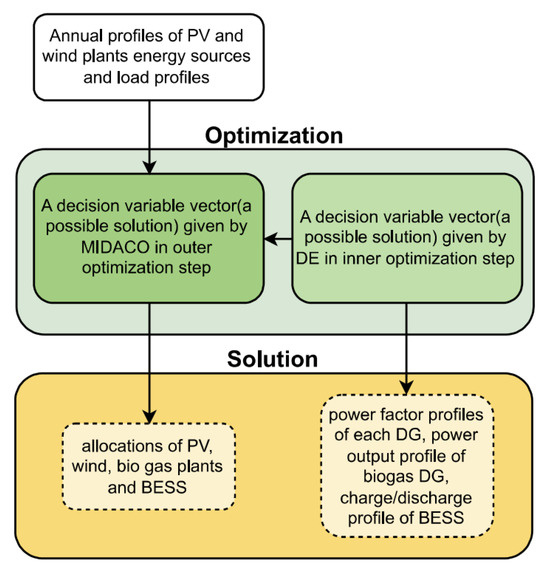
Figure 5.
Generating a possible solution to the optimization problem in outer and inner optimization steps in procedure Step 1.
The details of the interactions between outer and inner optimizations are shown in Figure 6. For each individual solution in the MIDACO solution population, the optimization of the DG power factor profiles, biogas power profile, and BESS power profile is optimized by DE in the inner optimization. The parameters of the tools used in this step of the procedure (Step 1: optimization) are
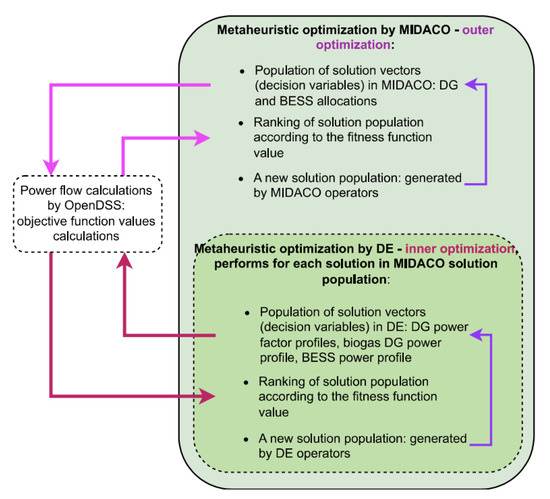
Figure 6.
Interactions and cosimulation among optimization tools (MIDACO and DE) in inner and outer optimizations and network simulation tool (OpenDSS) in Step 1.
- MIDACO: maximum number of objective function computations: 300, ant count: 50, kernel count: 5, termination criterion: maximum number of function evaluations;
- DE: maximum number of iterations/generations: 250, population size: 25, selection strategy: best1bin, recombination factor: 0.8, mutation factor: adaptive in the range (0.7, 1), termination criterion: maximum number of generations.
Step 2
As described in Step 1, the optimal DG and BESS allocations and all considered profiles are determined using some historical data from a previous year. However, the actual input data at some point in the year may differ from the values used during the optimization procedure. This means that in the implementation phase, for the optimal allocation determined in Step 1, the optimization of the optimized profiles (DG power factor, biogas power, and BESS operating condition) must be performed for any given time in the year. In order to simplify the use of the optimized allocation and to quickly obtain optimal profile values, ANN is proposed for generating the optimal profile values. Additionally, with the aim of simplifying the use, unlike Step 1, where the intensity of renewable energy sources was used as input data, here, the node voltages in DG and BESS installation nodes in the power grid are used as input to ANN. Node voltages are relatively easy to measure and are measured by default at DG and BESS. During the research, various designs of ANN are investigated to find the simplest ANN structure that gives results with satisfactory accuracy. The design of ANN shown in Figure 2 is proposed at the end of this research. The proposed ANN consists of an input layer, four hidden layers, and an output layer with 4, 8, 16, 16, 8, and 5 neurons, respectively. The number of neurons in the input and output layers is determined by the total number of DGs and BESS. The number of output neurons is further increased by the number of DGs, since one of the optimal profiles is related to the output power of the biogas. ANN is trained using the output and optimized input data obtained in Step 1. This means that the training set contained 4 times 8760 and 5 times 8760 input and output data, respectively.
The following ANN parameters are used for training (Figure 7):
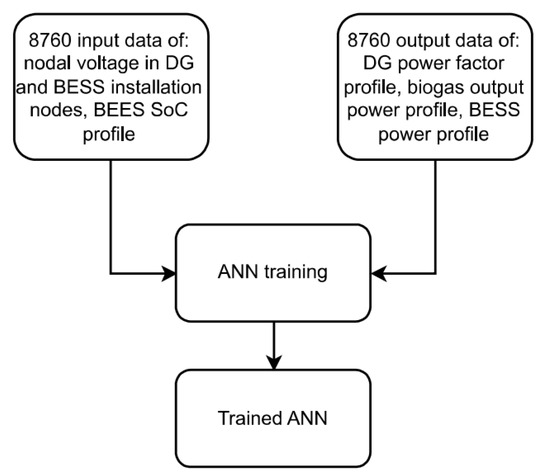
Figure 7.
ANN training in procedure Step 2.
- Type of layers: “dense”;
- Activation function of the hidden layers: “tanh”;
- Activation function of the output layer: “hard sigmoid”;
- ANN optimizer: “adagrad”;
- ANN loss function: “mean squared error”;
- ANN metrics: “mean square error”.
Step 3
After determining the optimal allocation of DG and BESS (in process Step 1) and training ANN to generate optimal profiles of the power factors of DGs, biogas production profile, and BESS profile (in procedure Step 2), the developed method is tested/verified in procedure Step 3 with input data different from those used in the previous two steps in the allocation optimization and training of ANN. The input data for this procedural step are generated by generating random numbers with different uncertainty ranges over the input data values according to the uniform distribution. The applied uncertainties for generating random input data were 10%, 50%, and 80% of the input data values used in procedure Steps 1 and 2. An overview of the procedure in Step 3 is shown in Figure 8.
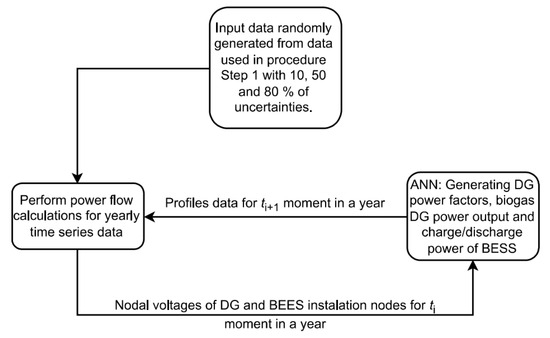
Figure 8.
ANN application in procedure Step 3.
5. Application of the Developed Method to a Case Study
The IEEE 37-node test network ([34]) is used as a case study to present the application of the proposed method to solve the optimization problem (3). The original test network has been adapted in terms of the taps of the voltage regulators. The taps are fixed at the center position (tap = 0) and are not changed during the simulations. The following software tools are used to generate input data:
- Online tool [35] is used to generate power profiles of PV and wind turbines.
- Software tool [36] is used to generate load profiles of grid customers.
The estimated input data can be generated by various forecasting methods based on previously collected historical data and used in the planning phase of implementing DG and BESS in the power distribution system. For such a data example, applying the procedure shown in Figure 3 for cases given in Table 1, the optimal locations and sizes of DG and BESS are found. The optimal allocation of the units BESS and DG, obtained by carrying out the procedure Step 1 for all the cases studied, is shown in Table 3.

Table 3.
Optimal BESS and DG allocations as solution to optimization problem (1) in procedure Step 1 (✗—DG/BESS not used in case).
Training and use of ANN, the proposed method in the implementation phase (Step 2 from Figure 3 and Figure 4).
The data used in the optimization procedure in the planning phase of the implementation of DG and BESS are estimated data. After the implementation of BESS and DG, the real input data (load patterns of consumers and production of PV and wind power plants) are more or less different from the data used in the optimization. Moreover, in a real distribution network, it is impractical to measure all loads at a given time. Therefore, in the implementation phase of DG and BESS units, the additional variables must be used to determine the optimal power profiles of BESS and controllable DG. ANN is proposed here to solve this problem. To find an optimal solution, the data about the voltage of the grid node for the optimal DG and BESS location are collected and used as the input data of ANN. The output data used for ANN training are the optimal phase shift and power profiles of DG and BESS. A schematic overview of the proposed structure of ANN is shown in Figure 2. After ANN is learned (trained), it can be used to estimate the optimal values of the outputs of DG and BESS for data that are different from those used in the planning phase (the previously performed optimization procedure). The data used to emulate the data in the implementation phase of the installation of DG and BESS are generated by adding some values to the initial input data. These additions are randomly generated using a uniform distribution around the data values used in the optimization phase. It is important to note that the values used in the optimization are not averages of the data generated in this way. The reductions in annual energy losses and energy exchange obtained for this case are given in Table 3. The generation of input data described above includes an uncertainty of the input data used in the optimization procedure (in the planning phase) and shows the robustness of the proposed procedure.
Figure 9, Figure 10, Figure 11 and Figure 12 provide a comparison of the values of the objective functions for all cases studied (these figures are obtained by optimization in Step 1 and by ANN in Step 2). The results in Figure 9, Figure 10, Figure 11 and Figure 12 were obtained for the load shapes and power profiles of PV and wind DG used in the optimization.
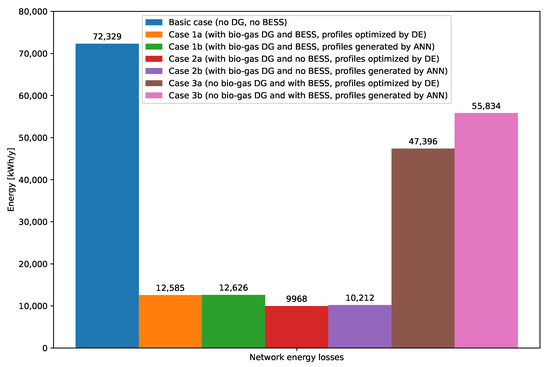
Figure 9.
Yearly energy losses for optimal allocations and profiles for all tested cases.
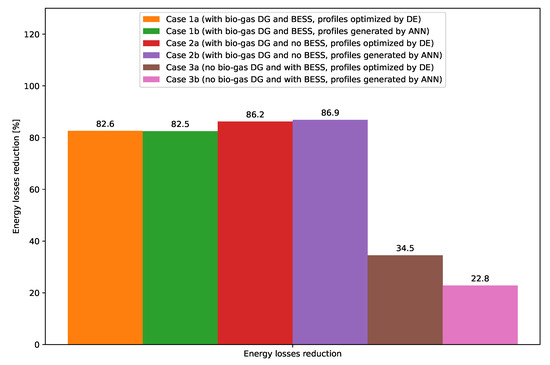
Figure 10.
Yearly energy loss reduction for optimal allocations and profiles for all tested cases.
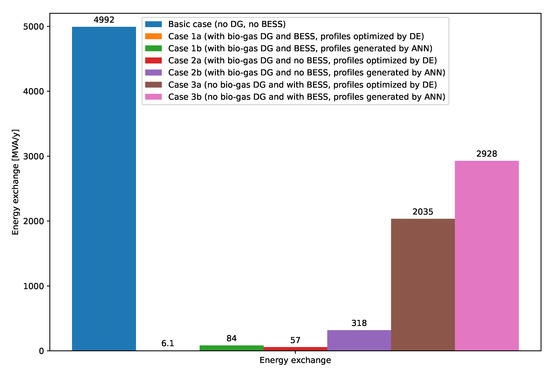
Figure 11.
Yearly energy exchange for optimal allocations and profiles for all tested cases.
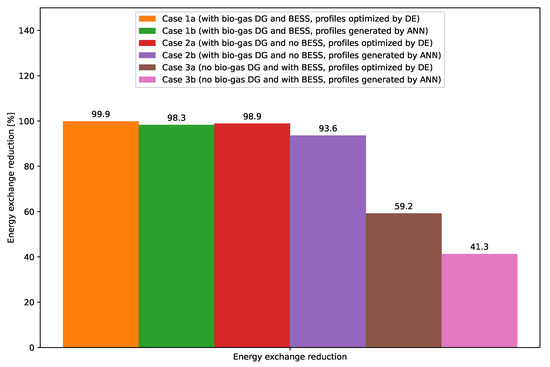
Figure 12.
Yearly energy exchange reduction for optimal allocations and profiles for all tested cases.
Effect of PV DG, wind DG, and consumer load profiles on optimization results (Step 3 from Figure 3 and Figure 4).
As described earlier in the procedure description, the input data for the PV and wing production profiles DG and the shape of the consumer load are used to obtain data that are used in Step 2 of the procedure to train the ANN generator (controller) from DG power factor profiles and output power profiles of biogas DG and BESS. Since the real data may be different from that used to train ANN, here, the different input data are applied to the optimally allocated DG and BESS and ANN is trained. Two scenarios with new data are used. In the first scenario, all input data are changed to model the uncertainty in the input data. The uncertainty in the data is modeled by adding a random number to the original data. This random number is generated using a uniform distribution for three levels of uncertainty: 10%, 50%, and 80%. The random number is added to the PV and wind production profiles DG and to the load profiles. The second scenario is performed by using the PV and wind generation data DG as in the ANN training, but the load curve is completely regenerated. For this purpose, the two different load curves are used. As mentioned before, this step of the procedure (Step 3) aims to investigate the generalization and robustness of the prediction of biogas and BESS power generation profiles and DG power factor profiles by ANN. The obtained results are presented in Table 4 and Table 5.

Table 4.
Objective function values (obtained using ANN profile controller) for different uncertainties in the input data (✗—there no energy losses/exchange reduction for Basic Case).

Table 5.
Objective function values (obtained using ANN profile controller) for different load shapes ( and ).
From the results in Table 4 and Table 5, it can be concluded that the proposed ANN profile controller is not suitable for Case 3, i.e., when there is no controllable DG in the power system. For this case, further research on other ANN controllers or other types of controllers for power factor and power profiles is needed.
The proposed framework can be useful in both the planning and operational phases of renewable energy implementation in the electricity distribution network. In the planning phase, the distributed generation and energy storage units are placed in the grid. For this purpose, some input data must be used. Once the units are installed on-site, their location cannot be changed. However, since the loads and intensity of the renewable energy sources are variable over time, the question is which data to consider and in which time horizon. Therefore, once the plants are on-site (in the implementation phase), they cannot be changed as the loads and intensity of the energy sources change. This means that the time horizon of the data used in the planning phase is crucial. This importance arises from the fact that optimal allocations determined for data in a time horizon that does not include all variations in the input data are not also optimal for some other data that may occur in the operational phase and are not considered in the planning phase. Of course, load and intensity change cyclically over the course of a year. Therefore, the answer to the question posed at the beginning is that in the planning phase, all changes in data during a year should be considered in order to include all these changes. In this way, the determination of optimal sizes and locations (both collectively referred to as allocation) is performed with more realistic input data. However, this is a major challenge, and this study attempts to help solve this problem. Even if the optimal allocation of units is found with a reasonable time horizon in the operational phase, additional optimization can be performed if there are some controllable parameters of the units. Such controllable parameters can be power factors (reactive power control) of inverter-based DG, output power of DG that can store energy sources in their basic form (such as biogas), and power and state of energy storage units. To address this problem in the operation phase, the proposed framework suggests the application of an ANN-based decision tool.
6. Conclusions
BESS is increasingly used in electricity distribution networks to improve the usability of renewable primary energy sources with uncontrollable intensity (solar radiation and wind) DG. The result of the conducted research presented above analyzes different combinations of the use of DG and BESS with the reduction of annual energy losses in the electricity distribution network and the exchange of energy with the higher-level electricity network. The obtained results allow the following conclusions:
- The application of DG with controllable intensity of the energy source, such as a biogas plant, reduces the size of the noncontrollable DG (PV and wind power plants), which results in not having to install a BESS unit in the power distribution network (this is evident from the results of cases 1 and 2 optimized in the study).
- The very complex optimization problem of simulatively optimizing BESS and DG allocations, annual power factor profiles, and annual power profiles of DG and BESS can be solved by a cosimulation approach using metaheuristic methods.
- The ANN-based control for the power factors of DG and the power profiles of controllable DG and BESS can be used to estimate the optimal values.
- The use of controllable DG can reduce power losses in the distribution system and in the exchange with the higher-level system much more than the use of BESS alone.
- The ANN generator of the optimal power factor profiles of DG and the power profile of BESS is very sensitive to data uncertainties when there is no controllable DG in the system.
- Using BESS only to reduce system losses results in significant amounts of BESS capacity and power that may be questionable in practical implementation in the distribution system.
Further research on this topic aims to apply the proposed method to a real-time simulator in a hardware-in-the-loop setup.
Author Contributions
Conceptualization, M.B. and G.K.; methodology, M.B.; software, M.B., G.K. and T.B.; validation, V.J.Š., G.K. and T.B.; formal analysis, M.B.; investigation, M.B., G.K. and V.J.Š.; resources, M.B. and G.K.; data curation, M.B. and T.B.; writing—original draft preparation, M.B.; writing—review and editing, M.B., G.K. and V.J.Š.; visualization, G.K.; supervision, M.B.; project administration, M.B.; funding acquisition, M.B. All authors have read and agreed to the published version of the manuscript.
Funding
This work has been supported in part by the Croatian Science Foundation under project number UIP-05-2017-8572.
Data Availability Statement
The input data and the trained ANN (in Tensorflow format, version TF 2.0) are available at: https://drive.google.com/drive/folders/1hzCER3G3WXmbi6LwnQXOt_TQhRGeoyS5?usp=sharing.
Conflicts of Interest
The authors declare no conflict of interest. The funders had no role in the design of the study; in the collection, analyses, or interpretation of data; in the writing of the manuscript; or in the decision to publish the results.
Abbreviations and Variable List
The following abbreviations are used in this manuscript:
| DG | distributed generation |
| BEES | battery energy storage system |
| PSO | particle swarm optimization |
| ALO | ant lion optimizer |
| BFO | bacterial foraging optimization |
| FA | firefly optimization algorithm |
| EV | electric vehicles |
| GA | genetic algorithm |
| GOA | grasshopper optimization algorithm |
| DE | differential evolution |
| MIDACO | mixed-integer distributed ant colony optimization |
The following variables are used in this manuscript:
| rated capacity (size) of BESS | |
| multiobjective function | |
| the first single-objective function | |
| the second single-objective function | |
| calculated line current | |
| maximum (rated) line current | |
| locations of the PV plants | |
| locations of the wind plants | |
| locations of the biogas plants | |
| locations of BESS | |
| output power profile values of biogas plant | |
| charge/discharge power profile values of biogas BESS | |
| rated power of BESS | |
| apparent power exchanged for period i | |
| active power losses for period i | |
| reactive power exchanged for period i | |
| active power exchanged for period i | |
| rated apparent powers (sizes) of biogas plants | |
| rated apparent powers (sizes) of PV plants | |
| rated apparent powers (sizes) of wind plants | |
| duration of period i | |
| minimum nodal voltage | |
| calculated nodal voltage | |
| maximum nodal voltage | |
| decision variable vector | |
| decision variable vector of inside optimization levels | |
| decision variable vector of outside optimization levels | |
| annual network energy losses, n number of periods | |
| annual energy (include active and reactive energy) exchange between the distribution and | |
| up-level network | |
| phase shifts between voltage and current (defining power factors) of the PVplants | |
| phase shifts between voltage and current (defining power factors) of the wind plants | |
| phase shifts between voltage and current (defining power factors) of the biogas plants |
References
- Stecca, M.; Elizondo, L.R.; Soeiro, T.B.; Bauer, P.; Palensky, P. A Comprehensive Review of the Integration of Battery Energy Storage Systems into Distribution Networks. IEEE Open J. Ind. Electron. Soc. 2020, 1, 46–65. [Google Scholar] [CrossRef]
- Zhou, W.; Dang, W.; Peng, F.; Mahesuti, R.; Zhang, L.; Sun, K. A decentralized peer-to-peer energy trading strategy considering flexible resource involvement and renewable energy uncertainty. Int. J. Electr. Power Energy Syst. 2023, 152, 109275. [Google Scholar] [CrossRef]
- Ding, Y.; Xu, Q.; Xia, Y.; Zhao, J.; Yuan, X.; Yin, J. Optimal dispatching strategy for user-side integrated energy system considering multiservice of energy storage. Int. J. Electr. Power Energy Syst. 2021, 129, 106810. [Google Scholar] [CrossRef]
- Xia, Y.; Xu, Q.; Huang, Y.; Du, P. Peer-to-peer energy trading market considering renewable energy uncertainty and participants’ individual preferences. Int. J. Electr. Power Energy Syst. 2023, 148, 108931. [Google Scholar] [CrossRef]
- Duan, P.; Zhao, B.; Zhang, X.; Fen, M. A day-ahead optimal operation strategy for integrated energy systems in multi-public buildings based on cooperative game. Energy 2023, 275, 127395. [Google Scholar] [CrossRef]
- Xia, Y.; Xu, Q.; Zhao, J.; Yuan, X. Two-stage robust optimisation of user-side cloud energy storage configuration considering load fluctuation and energy storage loss. IET Gener. Transm. Distrib. 2020, 14, 3278–3287. [Google Scholar] [CrossRef]
- Liu, J.; Hu, H.; Yu, S.S.; Trinh, H. Electricity Pricing and Its Role in Modern Smart Energy System Design: A Review. Designs 2023, 7, 76. [Google Scholar] [CrossRef]
- Cui, H.; Dai, W. Multi-objective optimal allocation of distributed generation in smart grid. In Proceedings of the International Conference on Electrical and Control Engineering, Yichang, China, 16–18 September 2011; pp. 713–717. [Google Scholar]
- Haitao, L.I.U.; Lun, X.U.; Zhang, C.; Xiao, S.U.N.; Jing, C.H.E.N. Optimal allocation of distributed generation based on multi-objective ant lion algorithm. In Proceedings of the IEEE Innovative Smart Grid Technologies—Asia (ISGT Asia), Chengdu, China, 21–24 May 2019; pp. 1455–1460. [Google Scholar]
- Moeini, A.; Kamwa, I.; de Montigny, M. Optimal multi-objective allocation and scheduling of multiple battery energy storages for reducing daily marginal losses. In Proceedings of the IEEE Power & Energy Society Innovative Smart Grid Technologies Conference (ISGT), Washington, DC, USA, 18–20 February 2015; pp. 1–5. [Google Scholar]
- Hosseini, K.; Araghi, S.; Ahmadian, M.B.; Asadian, V. Multi-objective optimal scheduling of a micro-grid consisted of renewable energies using multi-objective Ant Lion Optimizer. In Proceedings of the 2017 Smart Grid Conference (SGC), Tehran, Iran, 20–21 December 2017. [Google Scholar]
- Banerjee, S.; Sarkar, D. BFO-based firefly algorithm for multi-objective optimal allocation of generation by integrating renewable energy sources. Int. J. Grid Util. Comput. 2021, 12, 67. [Google Scholar] [CrossRef]
- Shi, X.; Ye, B.; Wang, X.; Yang, J.; Gao, C. Study on Optimal Allocation of Distributed Generation in Urban and Rural Distribution Network Considering Demand Side Management. In Proceedings of the 2017 International Conference on Smart Grid and Electrical Automation (ICSGEA), Changsha, China, 27–28 May 2017; pp. 560–566. [Google Scholar]
- Kumar, D.S.; Han, T.; Srinivasan, D.; Reindl, T.; Shenoy, U.J. Optimal distributed generation allocation using evolutionary algorithms in meshed network. In Proceedings of the 2015 IEEE Innovative Smart Grid Technologies—Asia (ISGT ASIA), Bangkok, Thailand, 3–6 November 2015. [Google Scholar]
- Phawanaphinyo, P.; Keeratipranon, N.; Khemapatapan, C. Optimal Active Power Loss with Feeder Routing Collaborate Distributed Generation Allocation and Sizing in Smart Grid Distribution. Adv. Econ. Bus. and Manag. Res. (AEBMR) 2017, 26, 387–392. [Google Scholar]
- Karunarathne, E.; Pasupuleti, J.; Ekanayake, J.; Almeida, D. Optimal Placement and Sizing of DGs in Distribution Networks Using MLPSO Algorithm. Energies 2020, 13, 6185. [Google Scholar] [CrossRef]
- Xue, X.; Zheng, Y.; Lu, C. Command Optimal Allocation Model of Distributed Energy System Based on Improved Firefly Algorithm. Distrib. Gener. Altern. Energy J. 2022, 37, 845–864. [Google Scholar] [CrossRef]
- Yu, M.; Li, B.; Wang, H.; Wang, X.; Negnevitsky, M. Multi-objective optimal scheduling of microgrid with electric vehicles. Energy Rep. 2022, 8, 4512–4524. [Google Scholar]
- Chen, K.; Li, H.; Wang, S.; Lu, J.; Shi, L. Modified Antipredatory Particle Swarm Optimization for Dynamic Economic Dispatch with Wind Power. Math. Probl. Eng. 2019, 2019, 5831362. [Google Scholar] [CrossRef]
- Kim, I. Optimal distributed generation allocation for reactive power control. IET Gener. Transm. Distrib. 2017, 11, 1549–1556. [Google Scholar] [CrossRef]
- Hassan, A.S.; Sun, Y.; Wang, Z. Multi-objective for optimal placement and sizing DG units in reducing loss of power and enhancing voltage profile using BPSO-SLFA. Energy Rep. 2020, 6, 158–1589. [Google Scholar] [CrossRef]
- Gampa, S.R.; Jasthi, K.; Goli, P.; Das, D.; Bansal, R.C. Grasshopper optimization algorithm based two stage fuzzy multiobjective approach for optimum sizing and placement of distributed generations, shunt capacitors and electric vehicle charging stations. J. Energy Storage 2020, 27, 101117. [Google Scholar] [CrossRef]
- Kumawat, M.; Gupta, N.; Jain, N.; Bansal, R.C. Optimally Allocation of Distributed Generators in Three-Phase Unbalanced Distribution Network. Energy Procedia 2017, 142, 749–754. [Google Scholar] [CrossRef]
- Akbar, M.I.; Kazmi, S.A.A.; Alrumayh, O.; Khan, Z.A.; Altamimi, A.; Malik, M.M. A Novel Hybrid Optimization-Based Algorithm for the Single and Multi-Objective Achievement with Optimal DG Allocations in Distribution Networks. IEEE Access 2022, 10, 25669–25687. [Google Scholar] [CrossRef]
- Mahmoud Pesaran, H.A.; Nazari-Heris, M.; Mohammadi-Ivatloo, B.; Seyedi, H. A hybrid genetic particle swarm optimization for distributed generation allocation in power distribution networks. Energy 2020, 209, 118218. [Google Scholar] [CrossRef]
- Quadri, I.A.; Bhowmick, S. A hybrid technique for simultaneous network reconfiguration and optimal placement of distributed generation resources. Soft Comput. 2020, 24, 11315–11336. [Google Scholar] [CrossRef]
- Huy, P.D.; Ramachandaramurthy, V.K.; Yong, J.Y.; Tan, K.M.; Ekanayake, J.B. Optimal placement, sizing and power factor of distributed generation: A comprehensive study spanning from the planning stage to the operation stage. Energy 2020, 195, 117011. [Google Scholar] [CrossRef]
- Pushpendra, S.; Nand, K.M.; Adam, S.; Shree, K.B. Modified African Buffalo Optimization for Strategic Integration of Battery Energy Storage in Distribution Networks. IEEE Access 2020, 8, 14289–14301. [Google Scholar]
- Barukčić, M.; Varga, T.; Štil, V.J.; Benšić, T. Co-Simulation Framework for Optimal Allocation and Power Management of DGs in Power Distribution Networks Based on Computational Intelligence Techniques. Electronics 2021, 10, 1648. [Google Scholar] [CrossRef]
- Dugan, R.C.; McDermott, T.E. An open source platform for collaborating on smart grid research. In Proceedings of the IEEE Power and Energy Society General Meeting, Detroit, MI, USA, 24–28 July 2011. [Google Scholar]
- Schlüter, M.; Egea, J.A.; Banga, J.R. Extended ant colony optimization for non-convex mixed integer nonlinear programming. Comput. Oper. Res. 2009, 36, 2217–2229. [Google Scholar] [CrossRef]
- Storn, R.; Price, K. Differential evolution—A simple and efficient heuristic for global optimization over continuous spaces. J. Glob. Optim. 1997, 11, 341–359. [Google Scholar] [CrossRef]
- Virtanen, P.; Gommers, R.; Oliphant, T.E.; Haberland, M.; Reddy, T.; Cournapeau, D.; Burovski, E.; Peterson, P.; Weckesser, W.; Bright, J.; et al. SciPy 1.0: Fundamental Algorithms for Scientific Computing in Python. Nature Methods 2020, 17, 261–272. [Google Scholar] [CrossRef] [PubMed]
- Distribution Test Feeder Working Group—IEEE PES Distribution System Analysis Subcommittee, Distribution Test Feeders. Available online: https://cmte.ieee.org/pes-testfeeders/wp-content/uploads/sites/167/2017/08/feeder37.zip (accessed on 10 August 2022).
- Pfenninger, S. Dealing with multiple decades of hourly wind and PV time series in energy models: A comparison of methods to reduce time resolution and the planning implications of inter-annual variability. Appl. Energy 2017, 197, 1–13. [Google Scholar] [CrossRef]
- Pflugradt, N.; Muntwyler, U. Synthesizing residential load profiles using behavior simulation. Energy Procedia 2017, 122, 655–660. [Google Scholar] [CrossRef]
Disclaimer/Publisher’s Note: The statements, opinions and data contained in all publications are solely those of the individual author(s) and contributor(s) and not of MDPI and/or the editor(s). MDPI and/or the editor(s) disclaim responsibility for any injury to people or property resulting from any ideas, methods, instructions or products referred to in the content. |
© 2023 by the authors. Licensee MDPI, Basel, Switzerland. This article is an open access article distributed under the terms and conditions of the Creative Commons Attribution (CC BY) license (https://creativecommons.org/licenses/by/4.0/).